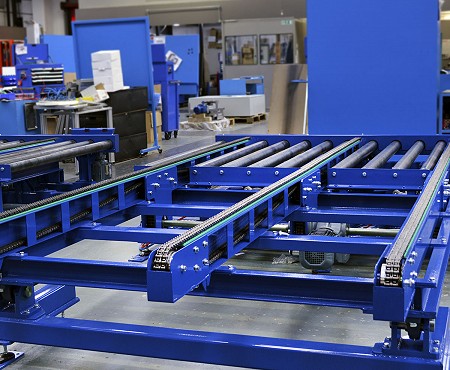WHAT IS A CHAIN CONVEYOR

Chain conveyors are tough and durable conveyors that are used to move products on an assembly line. They are suitable for various items that aren’t able to transport on a roller conveyor. This is why they are used to transport racks, pallets industrial containers and all products that have a solid lower surface. They are utilized in a variety of commercial and industrial settings such as storage facilities, automotive plants or distribution facilities.
Benefits
Chain conveyors are powered by a continuous chain, and they are typically used for transporting large loads. Chain conveyors generally come in a double strand configuration, with the load placed on the chain, however various strand configurations can be found.
Since chain conveyors are extremely easy to install, they typically require little maintenance and can be easily integrated into systems that incorporate CDLR as well as transfers. They are sometimes referred to as pallet conveyors due to their extensive use in transporting pallets made of steel or wood. Furthermore, various chain choices allow flexibility in the application and the environments they are used in.
Wainwrigte engineering services is among the top chain conveyor manufacturers. They can engineer and design custom conveyors, as being able provide rapid-ship “off the shelf” chains conveyor designs.
What are good uses of a chain conveyor?
- Moving heavy goods from one place to another. Chain conveyors are easy to use and extremely durable.
- The process involves moving the product through areas with high temperatures such as ovens, where other types of conveyors aren’t suitable.
- The transport of goods in continuous or indexing mode (i.e. the chain ends and begins each time to carry an item to the top of the chain with sensors)
- Conveyors for which changing the speed is needed. It is especially important when they are equipped with VFD (variable frequency drive) and chain driven system can be an easy conveyor that can be adjusted to change the speed.
Don’t use them if you need:
- Accumulating products (i.e. as buffers). Chain conveyors typically don’t permit the products to sit against one another (“accumulate”) with out moving the product off or sideways along the chain. If you require accumulation, choose the roller conveyor or power and overhead conveyors that are free.
- Items that don’t slide or slide away from the chain. Chain conveyors require the component to be able to travel along the chain without sliding. If you require the part to be secured while on the conveyor, think about an slat-type conveyor that could be equipped with tools to secure the product in place while the conveyor moves. Certain chains can be equipped with pins to hold skids and other positioning devices.
- Use the conveyor to serve as a surface for work. Chain conveyors are generally designed to transport objects, not for production processes on them. Utilize a slat or roller conveyor. If you’re using chains for a work surface certain safety precautions have be taken into consideration as the chain could be hazardous.
- Moving the products up or down on slopes. Since the items can slide on chains easily, they can pose a risk when used on inclines or declines
- Additionally, they are unable to transport a product through curves. Make use of a 90 degree transfer to transport products from one conveyor line
- In particular, items that have uneven or soft surface on the bottom will not be suitable for chain conveyors.
Technical specifications:
Depending on the weight of the product and the item being transported the chain type and tracks are offered and custom configurations are also available. Capacity ranges from 500lbs. up to 80,000 pounds for the two-strand chain conveyor.
- Heavy duty welded construction chain rails for structural tubes
- UHMW Polyethylene chain tracks offer durability, quiet operation, and power reduction
- Steel chain tracks to increase loads
- Chains of transfer with non-marring pads for glass or painted components
- The drive mounted in the center allows chains to move in reverse
- Custom-built to order – changes can be easily made
Track used for chain guides:
For loads that are lighter for lighter loads, For lighter load, Polyethylene track is utilized with the chain size C50, C60 and C80 (up to 3000 pounds.). This ensures the ability to withstand wear, provides quiet operation, and less power consumption. A special alloy steel track that is hardened is utilized on C80 (3000 pounds. and above), C100 and RC120 chain conveyors for increased capacity to carry loads and longer duration. For more details on the kinds of chains used in chains conveyor systems, visit this link.
Conveyor Chain
“C” series, straight side-bar chain with sizes C50 to C100 is employed. This chain is flat and reduces wear and damage to the product when as compared to the traditional roller chain.
Padded Chain
Transfer chain that has non-marring pads attached with the chain. Glass or painted components are a few examples of products that are able to be carried through this chain.
Belts
V-belts of polyurethane, also known as flat belts are offered for conveyor belts that are not marring.
Drive
A center-mounted drive permits the chain to travel in a reverse direction. The drive and pinch points are secured.
https://wainwright.com.au/chain-conveyor/




Leave a Reply